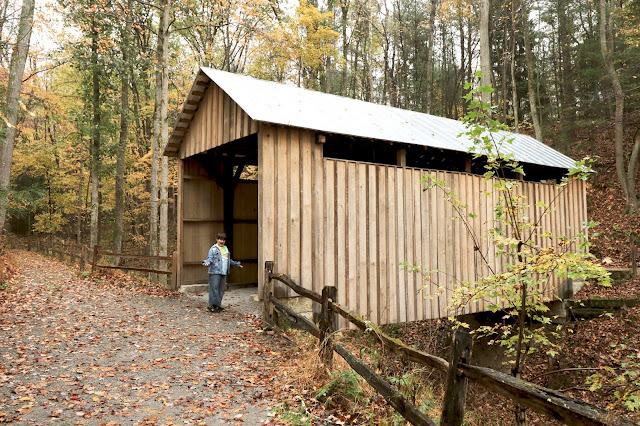Meadowcroft
Meadowcroft had several neat events planned, so we headed there on two consecutive weekends. We learned that Meadowcroft has two main areas. There is a historical area with both original and reconstructed structures to form a 16th century Native American village, an 18th century trading post and a 19th century village. Also there is the famous rock shelter, where in 1955, Albert Miller found a prehistoric flint tool in a groundhog hole on his family farm. It took him until 1973 to finally get an expert to take an interest, when anthropologist Dr. James Adovasio lead students on a dig. They revealed that a large rock shelter on the property had been used for 16,000 years by people to keep warm and dry while passing through the area. It is the oldest site of human habitation in North America yet confirmed.
On our first visit, we joined Meadowcroft volunteers for an old-fashioned taffy pull. We made a very chewy and scrumptious molasses taffy. It was great fun! Taffy turns out to be one of those things that seems very simple to make, as long as someone shows you how to do it. The taffy is cooked until it reaches the soft crack stage, and like most things involving the cooking of sugar, timing is everything. Once it's ready to be pulled, it's all hands on deck! It has to be done fast, before it cools, and since it's still pretty hot, everyone's hands have to be coated with butter. It's messy, delicious joy, perfect for a big gathering on a day with nasty weather. Afterwards we wandered around the villages, took in a one-room schoolhouse lesson and a blacksmith demo, stood inside a wigwam, and tossed an atlatl.
 |
| Jasper spotted this amazing spider, which we discovered is a marbled orb weaver. |
The following weekend we came back to Meadowcroft for a talk by Dr. James Adovasio himself. We learned a ton about the rock shelter. He explained that it seems to never have been a permanent home for anyone. The people who used it were small bands of hunter/gatherers who would have been on the move and would have been able to stay only until they exhausted the resources around it, perhaps a few weeks at most. Tools were sharpened there, but don't seem to have been made there. No objects that were not strictly utilitarian were left behind, and no artwork of any kind decorated the rock shelter. Who were they? We don't really know. We don't really have the cultural, linguistic or genetic evidence to ever have a definitive answer. We don't know where they were coming from, or where they were going to. They were just passing through.
When their team arrived, they found a fire pit with a few beer cans littering the ground. The fire pit had been used for some time, because beneath it they found beer cans that were left behind from the days when beer was sold in flat top steel cans without pull tabs. Beneath that were old bottles, then colonial era bottles, and even some bottle glass that had been flaked into tools by the native people.
 |
| Dr. Adovasio. |
 |
| Inside the rock shelter. |
 |
| The dig site from above. The exact spot of the groundhog hole that revealed the first artifact is nearby. |
















Comments
Post a Comment
Hello! I love to read your comments, but please be aware that they are moderated. This will result in a delay before they are posted. Thank you for your patience.